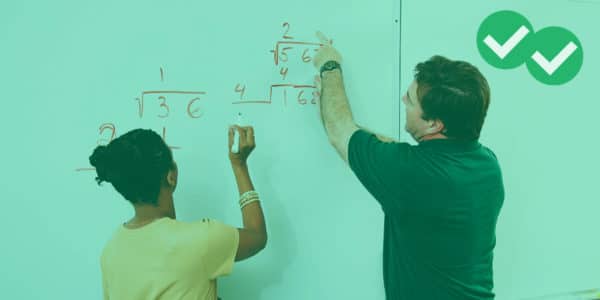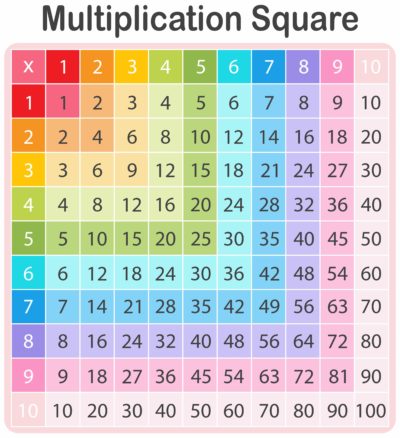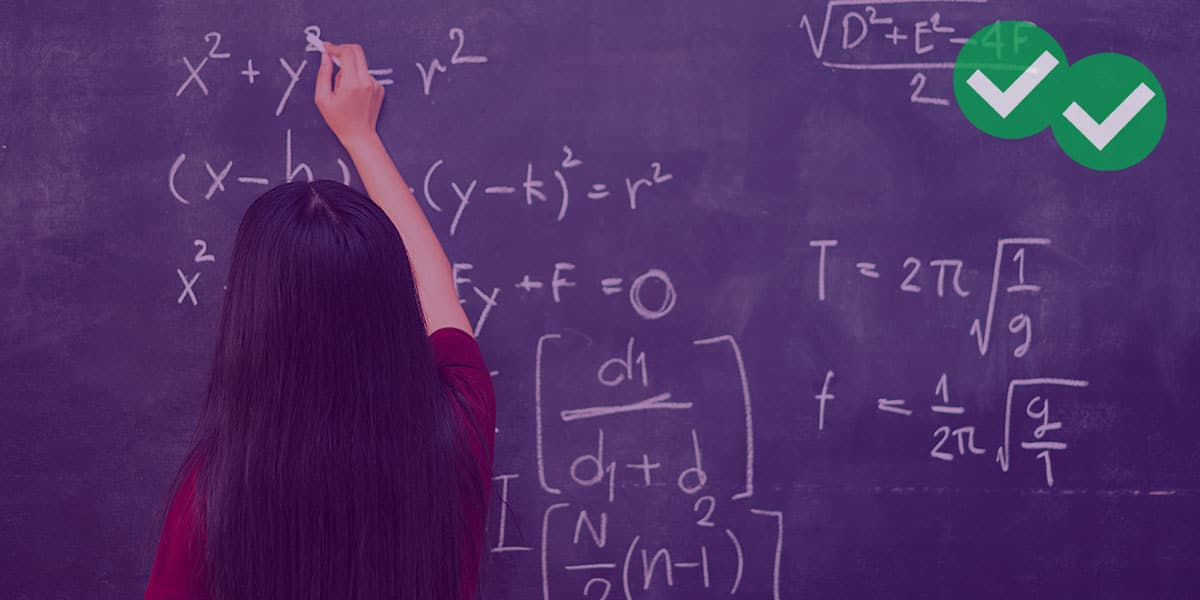
Achieving a high score on the GRE (Graduate Record Examination) is one of the major steps in landing a spot in the graduate school of your choice. But often, students struggle with the GRE math section.
The GRE Quantitative test has four main mathematical areas: Arithmetic, Algebra, Geometry, and Data Analysis.
This post is all about GRE arithmetic. But don’t let the name fool you! Arithmetic means much more than just adding and subtracting numbers. It covers a lot of ground, including general properties of numbers and how they are put together.
In this post, we’ll explore the various GRE arithmetic topics, which include things like divisibility, remainders, exponents, roots, percents, ratios, and sequences of numbers. We’ll also work through a few GRE arithmetic practice questions. Each example will be tagged as QC (quantitative comparison), MC (multiple choice), or NE (numeric entry). If you want to learn more about the question types on the GRE test, check out What Kind of Math is on the GRE?
Table of Contents
Numbers and Their Properties
Operations on Numbers
Ratios, Percents, and Proportions
Sequences
Numbers and their Properties
Remember your times table?

Each column or row displays the first ten multiples a given number. For example, the numbers 3, 6, 9, 12, 15, etc. are multiples of 3, or equivalently, those numbers are divisible by 3. (Of course, there are infinitely many more multiples—just imagine continuing each column or row forever!)
Numbers like 2, 3, 5, 7, 11, 13, 17, and 19, that are only divisible by 1 and themselves, are called the primes. There are infinitely many of those too! Primes are important because they are like the “Lego pieces” that fit together to make up all the other numbers out there.
![]() Watch our video to brush up on Divisibility Rules. You should also familiarize yourself with concepts such as prime factorizations of whole numbers, least common multiple (LCM), and greatest common factor (GCF) in the math section of the GRE.
Watch our video to brush up on Divisibility Rules. You should also familiarize yourself with concepts such as prime factorizations of whole numbers, least common multiple (LCM), and greatest common factor (GCF) in the math section of the GRE.
Example (MC): If an integer is divisible by both 12 and 27, then the integer must be divisible by which of the following?
(A) 48
(B) 54
(C) 81
(D) 108
(E) 324
Answer: (D)
Explanation: This question is really asking for the LCM of 12 and 27. First, get the prime factorizations of each number.
12= 22×3
27=33
If an integer is divisible by both 12 and 27, then it must have at least two factors of 2 and three factors of 3. The LCM is 22×33 = 4×27 = 108.
By the way, you could eliminate answer choices (A), (B), and (C), because each one fails to be divisible by one of the two numbers, 12 or 27. What about choice (E)? Isn’t that divisible by both 12 and 27? Well yes, it’s a common multiple, but it’s not the least common multiple.
![]() Try to avoid mindless calculator use by developing a good number sense and an aptitude for mental math. Check out this video on Number Sense and practice mental math with these problems. Also, check out these GRE Math Basics Quick Tips!
Try to avoid mindless calculator use by developing a good number sense and an aptitude for mental math. Check out this video on Number Sense and practice mental math with these problems. Also, check out these GRE Math Basics Quick Tips!
Example (QC):
n is a positive integer
Answer: The two quantities are equal.
Explanation: Quantitative comparison questions on the GRE ask you to decide whether one quantity is bigger than the other, the same, or cannot be determined.
The clue is that 21 is a multiple of 7, so when n+21 is divided by 7, the additional 21 will not contribute anything to the remainder.
Let’s double-check our thinking with a particular value, say n=36. The value 7 divides into 36 a total of 5 times, with a remainder of 1. What about n+21=57? Well, this time 7 goes into it 8 times, but the remainder is still 1.
Operations on Numbers
When you start to look at operations on numbers, it may seem that there are a ton of formulas to remember. In reality, there are just a few essential GRE arithmetic formulas and properties to master.
Integer
We’ve already used the term integer in this post, but in case you’re wondering exactly what an integer is…Briefly, integers are just the real numbers that do not have any fractional part (which do include negatives and zero).
Fractions
![]() For some solid fraction review, check out our videos on Intro to Fractions, Fraction Properties, and GRE Division, Mixed Numerals, and Negatives. Be sure you’re also familiar with the properties of negative numbers and absolute value.
For some solid fraction review, check out our videos on Intro to Fractions, Fraction Properties, and GRE Division, Mixed Numerals, and Negatives. Be sure you’re also familiar with the properties of negative numbers and absolute value.
Exponents
![]() Our Intro to Exponents video is a good primer. The general properties are key here: for example, a negative number raised to an even power gives you a positive, while a negative raised to an odd power keeps the quantity negative:
Our Intro to Exponents video is a good primer. The general properties are key here: for example, a negative number raised to an even power gives you a positive, while a negative raised to an odd power keeps the quantity negative:
(-)even = (+)
(-)odd = (-)
Example (MC): What is the sum of the digits of 28+(-3)5+(-4)2?
(A) 5
(B) 7
(C) 11
(D) 12
(E) 14
Answer: (C)
Explanation: 28+(-3)5+(-4)2 = 256 – 243 + 16 = 29. Add the digits to get the correct answer of 11.
Here is some more GRE Exponents Basics Practice.
Roots
![]()
You’ll also need to understand how to work with square roots and higher roots on the GRE. Here’s a helpful video on Simplifying Roots.
Example (NE): If √a=4 and ∛b=a, what is the value of b?
Answer: 4096
Explanation: √a=4 means “the square root of a number is 4.” You can guess and check, or better yet, translate the equation into: a=42, which is 16.
Then plug in a to the second equation: ∛b=16, and rewrite as: b = 163 = 4096.
Ratios, Percents, and Proportions
![]() When you need to compare two or more things, often a ratio, percent, or proportion is the best tool to use. For the basics of working with percents, check out this Intro to Percents as well as this video on Percent Changes.
When you need to compare two or more things, often a ratio, percent, or proportion is the best tool to use. For the basics of working with percents, check out this Intro to Percents as well as this video on Percent Changes.
Example (QC):
N is a positive real number.
Answer: Quantity B is bigger.
Explanation: Don’t be fooled; the quantities are not the same! Let’s work out the percent increase: N+0.20N=1.2N. Call that result M.
Now work out the percent decrease: M-0.2M=0.8M
Together, the two changes give: 0.8M=0.8(1.2N)=0.96N, which is less than N.
![]() Ratios and Proportions are basically about comparing fractions. Here are a few videos to get you started: Intro to Ratios and Proportions on the GRE.
Ratios and Proportions are basically about comparing fractions. Here are a few videos to get you started: Intro to Ratios and Proportions on the GRE.
Often, ratios or proportions show up in application questions, such as Distance-Rate-Time problems.
Example (MC): Stacy needs to drive 75 miles on a highway with a speed limit of 65 mph. If she starts at 3:00pm, and drives the speed limit, at what time can she expect to arrive at her destination?
(A) 3:56
(B) 4:03
(C) 4:07
(D) 4:09
(E) 4:13
Answer: (D)
Explanation: Use (Distance)=(Rate)(Time).
D=RT
75 mi.=(65 mph)T
T=75/65=1.1538 hr.
So, that’s an hour plus a fraction of the next hour. Multiply the fractional part by 60 to find the minutes: (0.1538)(60)=9.2
The closest answer choice is 4:09, which is an hour and 9 minutes after 3pm.
Sequences
![]() A sequence is just a list of numbers. Here are a couple videos that may help you to understand sequences: Intro to Sequences and Series and Counting.
A sequence is just a list of numbers. Here are a couple videos that may help you to understand sequences: Intro to Sequences and Series and Counting.
There are not many sequence problems on the GRE—maybe one will show up in a math section, but there could be none! So don’t spend too much time agonizing over all the formulas, techniques, and challenging theory in this topic. As long as you know the basics, you should be fine.
Example (NE): A sequence is defined by the rule, t1=3, t2=2, and for n≥3, tn=tn-1+2tn-2. What is the value of t5?
(A) 6
(B) 5
(C) 8
(D) 12
(E) 28
Answer: (E)
Explanation: You have to work out t3 and t4 first.
t3=t2+2t1=(2)+2(3)=8
t4=t3+2t2=(8)+2(2)=12
t5=t4+2t3=(12)+2(8)=28
Keep Practicing!
This GRE Arithmetic overview could not cover everything, so don’t forget to sharpen your skills by doing plenty of GRE Math Practice Questions as well as a GRE practice test or three! Training with a great test prep resource gives you the best chance of success on test day!






Leave a Reply